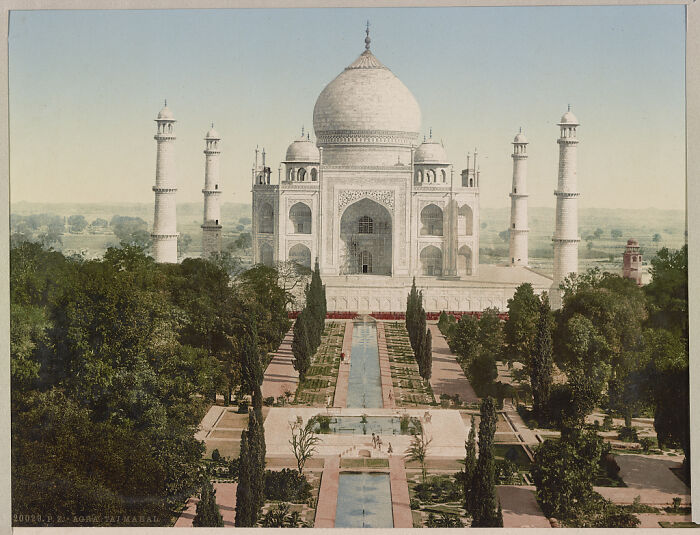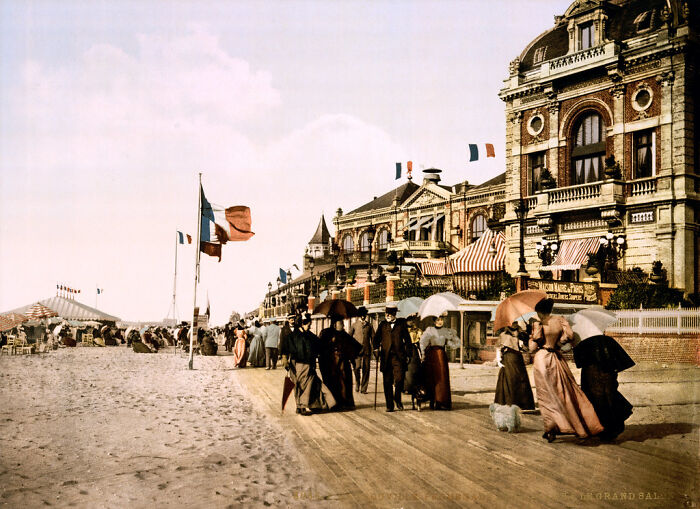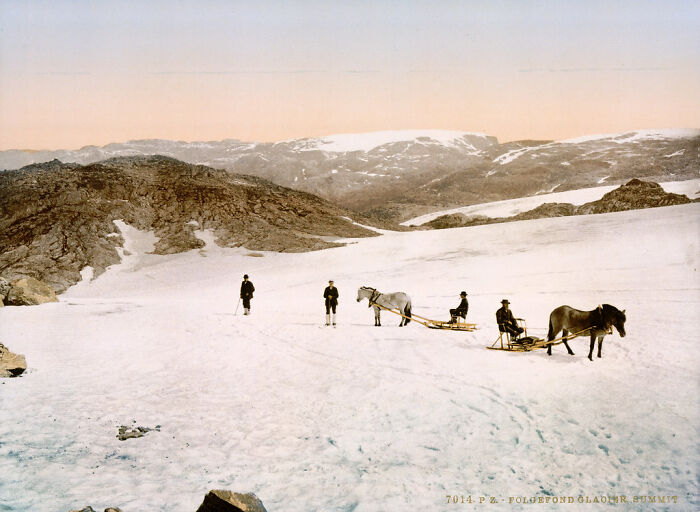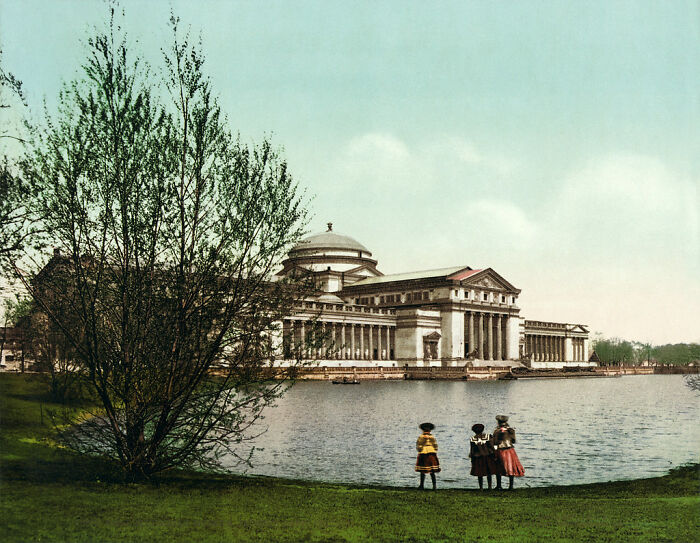I don't know about you, Pandas, but I love period dramas. They're like a window into the past: we can see how people looked and lived a hundred or even more years ago. However, they're often just interpretations of the past.
Why opt for how someone imagines what the world looked like when you have photographs that can show you? That's why we've put together a list of some of the oldest color photographs so we can all marvel at the ingenuity of photography and feel closer to the history of the places we now live in.
To learn more about the processes of the fascinating history of color photography, Bored Panda reached out to Mark Osterman. He's a former photographic process historian for the George Eastman House International Museum of Photography and Film who teaches workshops in early photographic processes from Niepce heliographs to gelatin emulsions. Osterman kindly agreed to take us behind the scenes of the makings of color photography.
#1 Irish Spinner And Spinning Wheel. Co. Galway, Ireland, 1890

Image credits: Detroit Photograph Company
#2 Winter Garden, Nice, France, Ca. 1895

Image credits: Photoglob Zürich
#3 Milksellers, Brussels

Image credits: Detroit Photograph Company
Historians date the oldest photograph to 1826 France. At least that's the oldest one that we know of today. That's when Joseph Nicéphore Niépce started experimenting with a camera obscura and took a snapshot of the view outside his window.
Scottish physicist James Clerk Maxwell took the world's first colored photograph. He experimented with red, blue, and green filters while photographing a ribbon. By projecting all three images onto a screen simultaneously, he was able to recreate the original image of the ribbon.
#4 East Face, Mont-Saint-Michel, Normandy, France, Ca. 1895

Image credits: Photoglob Zürich
#5 Christina In Red, 1913

Image credits: Mervyn O’Gorman
#6 Tour Eiffel & Exposition Universelle, Paris, France, 1889

Image credits: Photoglob Zürich
As evident from Niépce's and Maxwell's experiments, and as photographic process historian Mark Osterman told Bored Panda, the processes behind colored photographs were virtually unknown to the general public. "They were experimental," he explains.
However, what Maxwell did back then isn't so far off from how we get color photographs with our cameras and phones. "If you look at your computer or phone camera screen with a strong magnifier, they both rely on exactly the same technology," Osterman explains.
#7 London, Kodachrome

Image credits: Chalmers Butterfield
#8 Port Of Venice, Italy, Ca. 1889

Image credits: Photoglob Zürich
#9 Agra, Taj Mahal

Image credits: Miscellaneous Items in High Demand, PPOC, Library of Congress
"You will see red, green, and blue lines," he goes on. "The other colors are based on those lines being next to each other. For instance, yellow is a virtual mixture of red and green lines next to each other. White is actually all three colors next to each other!"
#10 Photochrom Print By Photoglob Zürich, Between 1890 And 1900

Image credits: Detroit Photograph Company
#11 Luce Ben Aben, School Of Arab Embroidery, Algiers, Algeria, Ca. 1899

Image credits: Photoglob Zürich
#12 Promenade And Grand Salon, Trouville, Normandy, France, Ca. 1895

Image credits: Photoglob Zürich
French brothers Auguste and Louis Lumière were the first to patent the autochrome: a method of color photography. What is the autochrome, exactly? It's when plates are covered in microscopic red, green, and blue grains of starch, and when light passes through them, it combines to recreate a full-color image of the original.
#13 Singers' Hall (Music Room), Neuschwanstein Castle, Upper Bavaria, Germany, 1886

Image credits: Photoglob Zürich
#14 Folgefonn Glacier, Hardanger Fjord, Norway, Ca. 1897

Image credits: Photoglob Zürich
#15 Neuschwanstein, Upper Bavaria, Germany

Image credits: Detroit Photograph Company
Even though the autochrome was patented in 1903, that doesn't mean that it was readily available to the public. "Only affluent amateur photographers were shooting them aside from the professional photographers, who worked for the National Geographic Magazine," Osterman told us. "This was because the color transparency plates could be used to produce three color printing plates to make full-color ink-printed reproductions in their magazines."
#16 Oberammergau, Upper Bavaria, Germany

Image credits: Detroit Photograph Company
#17 Townhall, Hildesheim, Lower Saxony, Germany

Image credits: Detroit Photograph Company
#18 La Corniche, Marseille, France, Ca. 1895

Image credits: Photoglob Zürich
"There was a two-color process invented around 1913 by Kodak that used two glass plates in contact with each other, one being red-orange and the other being green-blue," Osterman goes on. "Called the two-color Kodachrome process, it was beautiful, but the dyes being from Germany and the US entering the war made it impossible for Kodak to put the process into production. None were sold."
#19 Field Columbian Museum, Jackson Park, Chicago, 1901

Image credits: Photoglob Zürich
#20 North German Lloyd Mail Steamer König Albert, First Class Dining Room, Ca. 1910

Image credits: Photoglob Zürich
#21 Photo Family Hungary - Kapeller

Image credits: Madboy74
"The product name Kodachrome resurfaced in the 1930s with a three-color chromogenic process, a variant that we still use today," Osterman continues. While these 35 mm color slides (aka transparencies or diapositives) were known in the 1930s by both Kodak (US) and Agfa (Germany), only the amateurs were using them."
#22 Panorama Of The Seven Bridges, Paris, Ca. 1895

Image credits: Photoglob Zürich
#23 The Colosseum, Rome, Italy, Ca. 1896

Image credits: Photoglob Zürich
#24 View From The Hotel Fasano, Fasano, Lago Di Garda, Italy, Ca. 1895

Image credits: Photoglob Zürich
People had to wait for the war to end for color films to appear on the market. "It wasn't until after WWII that color films were widely available for everyone and professionals started using them in publications," Osterman says. "By the 1960s, portrait studios were routinely offering color photographic prints from color negatives."
#25 The Cathedral, Amsterdam, Holland

Image credits: Detroit Photograph Company
#26 Oudezijds Kolk, Amsterdam, North Holland, The Netherlands, Ca. 1901

Image credits: Photoglob Zürich
#27 Roches Royal Hotel, Glengariff Harbor, Ireland, Ca. 1895

Image credits: Photoglob Zürich
Most amateur photographers and perhaps even some professionals might not know that all color plates, films, and papers are actually coated with black and white gelatin emulsions. "The image is taken by that black and white sensitive emulsion and the color becomes visible during processing," Mark Osterman explains to Bored Panda. "After the color image is established, the black silver-based image is dissolved away, leaving the color behind."
#28 1937

Image credits: Thomas Neumann
#29 Fingal's Cave, Staffa, Scotland

Image credits: Detroit Photograph Company
#30 Interior Of Corridors, Mission San Juan Capistrano

Image credits: Detroit Photograph Company
Perhaps we have some photography enthusiasts among Pandas, too? If you're into the history of photography or the processes behind photo-making, let us know in the comments your favorite part of the process! And if you're looking for more old photographs that are in color, be sure to check out our previous article here!
#31 Mulberry Street, New York City

Image credits: Detroit Photograph Company
#32 The Coo Waterfalls Near Spa, Belgium, Ca. 1895

Image credits: Photoglob Zürich
#33 Cypresses And Road Leading To The Cemetery, Scutari, Constantinople, Turkey, Ca. 1895

Image credits: Photoglob Zürich
#34 Kungstradgarden, Stockholm, Sweden

Image credits: Detroit Photograph Company
#35 Victoria Hotel, Unter Den Linden, Berlin, Ca. 1900

Image credits: Photoglob Zürich
#36 Fontainebleau Palace, Fontainebleau, France, Ca. 1897

Image credits: Photoglob Zürich
#37 Stockholmsutställningen 1930 Villa

Image credits: Cronquist, Gustaf
#38 "Osborne", Royal Yacht, Hmy Osborne II

Image credits: Detroit Photograph Company
#39 Shelbourne Hotel. Dublin

Image credits: Detroit Photograph Company
#40 Early Color Photo Of Agen, France, By Louis Ducos Du Hauron, 1877. The Cathedral In The Scene Is The Cathédrale Saint-Caprais D'agen

Image credits: Louis Ducos du Hauron
#41 A Photochrom Postcard Published By The Detroit Photographic Company

Image credits: Unknown author
#42 Arthur Rothstein: Boy Building A Model Airplane As Girl Watches, Fsa Camp, Robstown, Texas, 1942

Image credits: Photoglob Zürich
#43 Jack Delano: Chicago And Northwestern Railroad Locomotive Shop, Chicago, Illinois, 1942

Image credits: Photoglob Zürich
#44 Jack Delano: Sideshow Barker At The State Fair, Rutland, Vermont, 1941

Image credits: Photoglob Zürich







